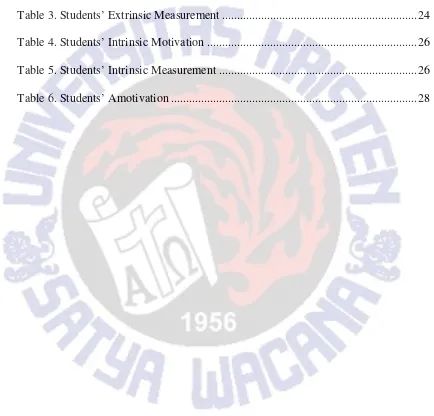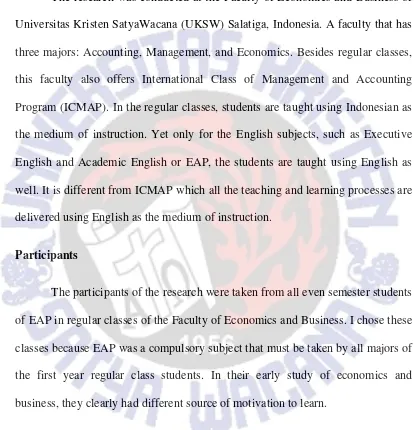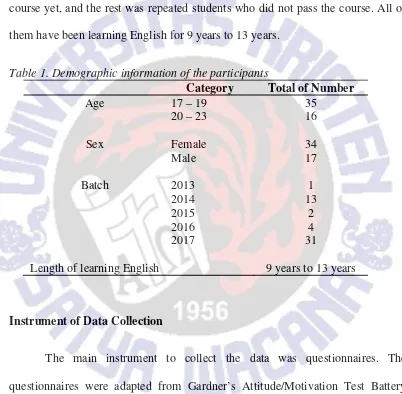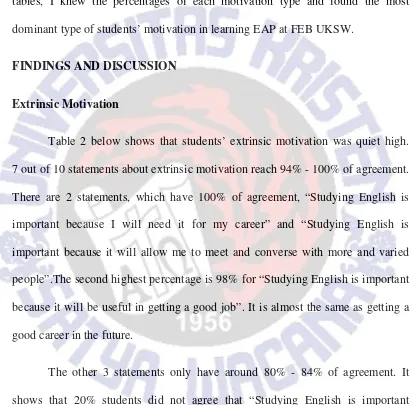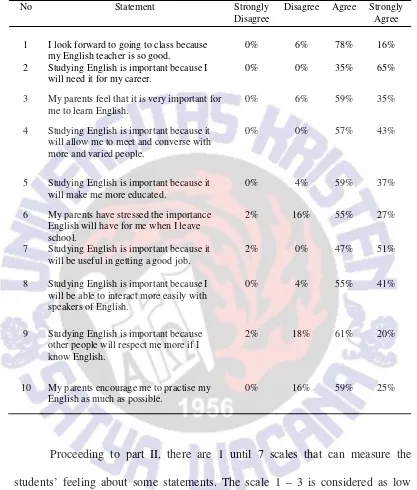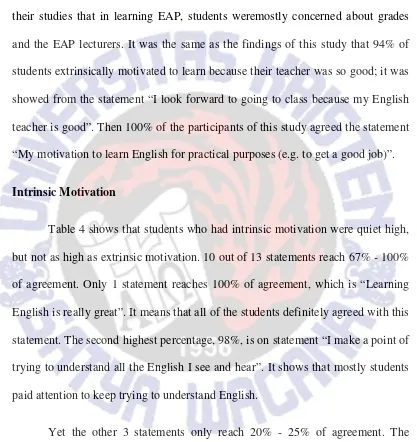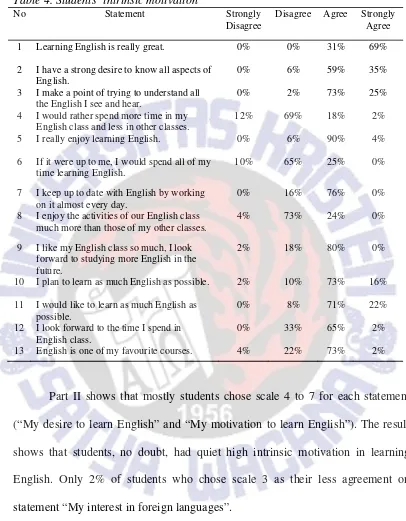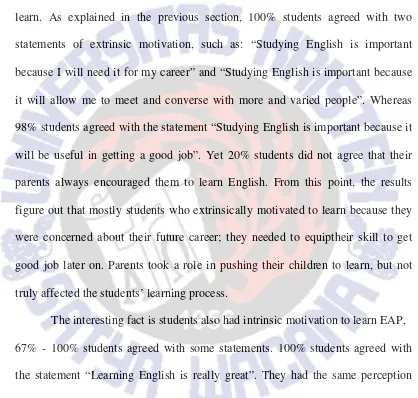STUDENTS’ MOTIVATION TO LEARN ENGLISH FOR
ACADEMIC PURPOSES AT THE FACULTY OF ECONOMICS
AND BUSINESS
THESIS
Submitted in Partial Fulfillment
of the Requirements for the Degree of
Sarjana Pendidikan
Mariana
112014025
ENGLISH LANGUAGE EDUCATION PROGRAM
FACULTY OF LANGUAGE AND ARTS
UNIVERSITAS KRISTEN SATYA WACANA
SALATIGA
2018
STUDENTS’ MOTIVATION TO LEARN ENGLISH FOR
ACADEMIC PURPOSES AT THE FACULTY OF ECONOMICS
AND BUSINESS
THESIS
Submitted in Partial Fulfillment
of the Requirements for the Degree of
Sarjana Pendidikan
Mariana
112014025
ENGLISH LANGUAGE EDUCATION PROGRAM
FACULTY OF LANGUAGE AND ARTS
UNIVERSITAS KRISTEN SATYA WACANA
SALATIGA
2018
ii
iii
iv
COPYRIGHT STATEMENT
This thesis contains no such materials as has been submitted for examination in any course or accepted for the fulfillment of any degree or diploma in any university. To the best of my knowledge and my belief, this contains no material previously published or written by any other person except where due reference is made in the text.
Copyright@ 2018. Mariana and Anita Kurniawati, M. Hum.
All right reserved. No part of this thesis may be reproduced by any means without the permission of at least on of the copyright owners or the English Language Education Program, Faculty of Language and Arts, Universitas Kristen Satya Wacana, Salatiga.
Mariana
vi
TABLE OF CONTENTS
Inside Cover Page ... i
Pernyataan Tidak Plagiat... ii
Pernyataan Persetujuan Akses... iii
Approval Page ... iv
Copyright Statement ... v
Declaration ... vi
Table of Contents ... vii
List of Tables ... ix
Abstract ... 10
INTRODUCTION ... 10
LITERATURE REVIEW ... 12
Motivation in Learning Process ... 12
Types of Student’s Motivation ... 13
Experiences of Student’s Motivation in Learninig EAP ... 16
Brazilian public institution ... 16
The university of Hong Kong ... 17
The Faculty of Health and Sciences of UKSW ... 18
THE STUDY ... 19
Context of the Study ... 19
Research Participants ... 19
Data Collection Instrument ... 20
Data Collection Procedure ... 21
Data Analysis ... 22
FINDINGS AND DISCUSSIONS ... 22
Extrinsic Motivation ... 22
Intrinsic Motivation. ... 25
Amotivation ... 28
CONCLUSION ... 30
ACKNOWLEDGEMENTS ... 33
REFERENCES ... 34
APPENDIX A ... 36
ix
LIST OF TABLES
Table 1. Demographic Information of the Participants ... 20
Table 2. Students’ Extrinsic Motivation ... 23
Table 3. Students’ Extrinsic Measurement ... 24
Table 4. Students’ Intrinsic Motivation ... 26
Table 5. Students’ Intrinsic Measurement ... 26
STUDENTS’ MOTIVATION TO LEARN ENGLISH FOR
ACADEMIC PURPOSES AT THE FACULTY OF ECONOMICS
AND BUSINESS
Mariana
ABSTRACT
Many experts and researchers have agreed that motivation is an important component in learning process. This study aims to investigate the most dominant type of students’ motivation to learn English for Academic Purposes (EAP) at the Faculty of Economics and Business (FEB), whether extrinsic, intrinsic or even amotivation. Data from 51 students of EAP class were collected by distributing close – ended questionnaires. The questionnaires were adapted from Gardner’s Attitude/Motivation Test Battery (Gardner, 2004). It shows that the most dominant motivation type that students have during the EAP class is extrinsic motivation. The findings may help EAPlecturers to adjust the teaching and learning strategies so that the students keep being motivated during the learning process.
Keywords: students’ motivation, extrinsic motivation, intrinsic motivation, amotivation, EAP
INTRODUCTION
Motivation is one of factors that can be highlighted to determine
someone’s success in learning. A student needs to have a strong desire to achieve
the learning objectives. Since motivation underlies the students’ learning process,
many educational practices have already paid much attention on it. Gregory
(2009) points out that “Although students may be equally motivated to perform a
task, the sources of their motivation may differ”. Students who intrinsically
motivated will learn readily, they even like challenges, because they are truly
interested in learning the subject. Then, students who are extrinsically motivated
will learn because they have to, one of the reasons is that they need to get good
marks to please their teachers or parents. Ryan &Deci (2000) also introduces
another type of motivation, amotivation, which refers to students who are lack of
interest of learning, or do not like to learn. They do not have desire to do things,
do not believe in themselves, and also do not feel competent to do things.
Motivation always influences every teaching and learning process in all
academic contexts. One of the contexts is English for Academic Purposes (EAP).
It has been a familiar term in education. English is taught for other academic
purposes that contains spoken, written, visual, and electronic academic texts
(Hyland, 2006). Nowadays, there are many universities that have been applying
EAP in their programs. Universitas Kristen SatyaWacana in Salatiga also has this
subject at the Faculty of Economics and Business (FEB). EAP in this faculty is a
compulsory subject that must be taken by all first year students in the first
semester. EAP itself is spesifically for academic context (Hamp – Lyons, 2016).
Chan(2004) andDornyei&Ushioda (2011) as cited in Yung (2013) stated that
“first year students in many universities are required to take courses of EAP.
However, because of the compulsory nature of these courses, many students are
instrumentally motivated or negatively motivated.”
This research is a survey study which aims to investigate the most
dominant type of students’ motivation to learn EAP at the Faculty of Economics
and Business, whether extrinsic, intrinsic or even amotivation. The study is
conducted to help EAP lecturers adjust the teaching and learning strategies so that
the students keep being motivated during the learning process. Therefore, the
research question that underlies this study is: What is the most dominant type of
students’ motivation to learn EAP at the Faculty of Economics and Business?
LITERATURE REVIEW
Motivation in Learning Process
Many experts such as Wechsler(2006), Pfromm(1987), Schunk(1991), and
Mitchell, Jr. (1992)as cited in Leal, Miranda, and Carmo(2012), have conducted a
study which showed that motivation can affect learning process and, conversely,
learning process can also affect motivation. In addition, Parsons, Hinson and
Brown (2001) as cited in Wimolmas (2013) defined that
Motivation is an important component or factor in the learning process. Learning and motivation have the same importance in order to achieve something. Learning makes us gain new knowledge and skills and motivation pushes us or encourages us to go through the learning process.
The definition above explains that learning and motivation have the same
importance to gain something. Leaning helps someone to achieve a particular
abilities, skills, or knowledge, while motivation pushes and gives courage to learn.
For Miller and Dollard (1941), “learning takes place when the learner
wants something, notices something, does something, and receives something”.
Motivation is the first essential component of learning (as cited in Gardner &
Lambert, 1972); it is important to determine someone’s success in learning. If the
students’ motivation is zero, a learning objective might not be achieved fruitfully.
Similar to Miller and Dollard,Gilbert (2011) also indicated that students’
motivation as the single most important component of learning. Highly motivated
students will learn enthusiastically, they will see learning as an enjoyable thing to
do. Otherwise, unmotivated students will see learning as a boring and frustrating
thing to do; they will not have any desire to willingly learn something. Learning is
likely to occur if only the students want to learn. The four factors that influence a
motivation is interest, curiosity, and desire to achieve the goal (Williams &
Burden, 2009).
Types of Student’s Motivation
The sources of students’ motivation may be different from one to another. Ryan
and Deci (2000) identified three big types of motivation which are extrinsic,
intrinsic, and amotivation.
Extrinsic Motivation
Harmer (1991), as cited in Wimolmas(2013) stated that extrinsic
motivation is a type of motivation when a student wants to learn well because they
need to achieve a particular goal, such as a reward of getting good marks. It is
actually not that good for learning, because if they do not have any goal to learn,
they will not readily to learn. They will not be interested in learning anymore
when there are not supporting factors.
Csikszentmihalyi and Nakamura (1989), as cited in Williams &
Burden(2009), had similar thoughts “When the only reason for performing an act
is to gain something outside the activity itself, such as passing an exam, or
obtaining financial rewards, the motivation is likely to be extrinsic.”They defined
that one of extrinsic motivation’s characteristics can be seen from the reason of a
person who does a particular act. It will be categorized as extrinsic motivation if
the reason is only to achieve something outside the activity itself.
Then Vasquez (2009) also similarly described that extrinsic motivation
comes from outside of the students, such as a force from others. For instance, a
student learns well because his parents have demanded good grades for his
academic report. A fact stated by Lepper (1988), as cited in Gregory (2009),
toward one of extrinsic motivation characteristics that“An extrinsically motivated
student performs - in order to obtain some reward or avoid some punishment
external to the activity itself, such as grades, stickers, or teacher approval.”It
means that students who are extrinsically motivated may learn just because of
chasing good grades, rewards, or teacher approvals even only for avoiding some
punishment outside the subject that they learn.
To sum up, extrinsic motivation is a type which generally students have –
in order to obtainrewards, or only to please other people, so it comes from
external factors of the students. They would have fewer efforts to do anything
because their orientation is not to the maximal results. They tend to like tasks with
low difficulties (Gregory, 2009).
Intrinsic Motivation
In contrast, intrinsic motivation is a strong desire that comes from the
students themselves. If they have intrinsic motivation, they will learn readily
without external factors (Arnold, 2000, p. 14, as cited in Wimolmas, 2013). This
type of motivation comes from a person himself; it causes a long – term
motivation (Lai, 2011). Lepper (1988) as cited in Gregory (2009) stated that“A
student who is intrinsically motivated undertakes an activity for its own sake, for
the enjoyment it provides, the learning it permits, or the feelings of
accomplishment it evokes.”The statement explains that a student who has intrinsic
motivation to learn will learn willingly for they love to, and they feel enjoy in
doing any activities regarding the subject they learn.
SimilartoLepper (1988), Leal et al. (2012) highlighted a point that
underlies intrinsic motivation; the point is “enjoyment”. Students learn a
particular course for they are enjoyable to learn it. When students are intrinsically
motivated, they tend to give much efforts to gain what they really want, arranging
strategies and also think about it deeply. Moreover, students with this kind of
motivation would like to have challenging tasks which require creativity and good
strategies (Gregory, 2009). If students willingly learn, they will surely engage a
task and have such a curiosity to learn the knowledge deeper; it comes from their
internal factors (Kitjaroonchai&Kitjaroonchai, 2012).
Amotivation
The third type of motivation is amotivation,which refers to a person who is
lacking the interest of doing something and feeling not competent to do so. Ryan
&Deci (2000) pointed out that there is a type which contrasts with motivation,
amotivation type. It is when a student is lacking of motivation to learn. They do
not have a strong desire to learn, even they are not willingly to take part in
activities, not feeling confident and capable to do things, also do not believe in
themselves.
Some experts, Barkoukis, Tsorbatzoudis, Grouios, and Sideridis (2008),
Leal et al. (2012) strengthen the notion above by stating that individuals who are
categorized in amotivation type have no clear goals or purposes of what they are
doing. They do not have interest to do it, and do not feel competent to join in the
activity. Therefore, they also do not want to engage in the activity.
Experiences of students’ motivation in learning EAP
Faculties of some universities in the world have EAP as one of their
courses. Some researchers have done studies regarding to students’ motivation in
learning EAP at a particular university, such as Leal et al. (2012) who conducted a
study in all academic terms of the Accounting Sciences program of a public
higher education institution in Brazil,Yung (2013) who conducted a study at The
University of Hong Kong and Berninda (2015) who conducted a study at the
Faculty of Health and Sciencesof UKSW, Salatiga, Indonesia.
Brazilian Public Institution
Leal et al. (2012)conducted a study in all academic terms of the
Accounting Science program of a public higher education institution in Brazil.
The study was entitled “Self – Determination Theory: An Analysis of Student
Motivation in an Accounting Degree Program”. It took 259 students to be their
participants. The study aimed to “evaluate the motivation of Accounting Science
students in a public university in light of the Self – Determination Theory”. Then
they got the results that some students learnt the subject deeply because of their
future career, and others were only concerned about getting the diploma. From
this result, they found that extrinsic motivation was the most dominant type of
students’ motivation in learning EAP. Then they highlighted that from the study,
EAP lectures could understand the motivational processes and their relevant
teaching strategies in the classroom.
The University of Hong Kong
The environment in Hong Kong is similar to many countries in Asia. The
pupils in that countries are not accustomed in using English as their daily
language; the chances to use English is quiet limited (Yung, 2013). Hence, Yung
(2013) conducted a study entitled “Bridging the Gap: Motivation in Year One
EAP Classrooms”. The study aimed to “bridge the gap of the missing one year
English learning experience in secondary school” (Yung, 2013). The participants
were 14 first year Hong Kong local undergraduates at the University of Hong
Kong and interview was used to collect data. There is no exact percentage from
the results of the study. Yet he stated the results generally that“because of the
highly structured and authority – oriented learning style, students tended to be
teacher – dependent, passive, focusing on examination success and examination
skills & tips” (Yung, 2011 as cited in Yung, 2013). The case above showed that
students learn for only getting good grades. They tended to have extrinsic
motivation as their motivation to learn.
The Faculty of Health and Sciences of UKSW
Berninda (2015) had conducted a similar study entitled “Students’
Learning Motivation in English for Academic Purposes (EAP) Class” in the
Faculty of Health and Sciences of UKSW, Salatiga, Indonesia. She used
questionnaires and interview as the data intruments of her study. Then she got 52
as the participants. They were chosen from random program studies of the faculty.
The findings of this study showed that all the participants highly motivated to
learn the subject. Mostly, they were extrinsically motivated. The participants
viewed English as an compulsory subject that they must take. They had desire to
learn English because English was a valuable knowledge for them. Yet, the
highest factors that affected the participants’ motivation were class activities,
grades, and also the EAP lecturers. Then the interview result showed that students
suggested to learn EAP that fit to their own program study. Since their most
dominant motivation was extrinsic motivation, so they think this way will be more
motivating them in learning English.
The three previous studies above, were conducted indifferent faculties of
universitiesof different countries. This present studyaddresses the same issue but
it was held in the Faculty of Economics and Business of UKSW. The following
section, findings and discussion, shows the comparison between the findings of
the previous studies and the findings of this study.
THE STUDY
Context
The research was conducted at the Faculty of Economics and Business of
Universitas Kristen SatyaWacana (UKSW) Salatiga, Indonesia. A faculty that has
three majors: Accounting, Management, and Economics. Besides regular classes,
this faculty also offers International Class of Management and Accounting
Program (ICMAP). In the regular classes, students are taught using Indonesian as
the medium of instruction. Yet only for the English subjects, such as Executive
English and Academic English or EAP, the students are taught using English as
well. It is different from ICMAP which all the teaching and learning processes are
delivered using English as the medium of instruction.
Participants
The participants of the research were taken from all even semester students
of EAP in regular classes of the Faculty of Economics and Business. I chose these
classes because EAP was a compulsory subject that must be taken by all majors of
the first year regular class students. In their early study of economics and
business, they clearly had different source of motivation to learn.
Table 1 below describes the demographic information of the participants in which
from 51 students, 34 (67%) of female and 17 (33%) of male with different age
groups: 35 (68%) of students from 17 to 19 years of age, and 16 (32%) of students
from 20 to 23 years of age. They came from two regular classes which had
random batch and major: 1 (2%) student from 2013 batch, 13 (25%) students from
2014 batch, 2 (4%) students from 2015 batch, 4 (8%) students from 2016 batch,
and 31 (61%) from 2017 batch. The participants consisted of students from
random batches and those who major in Accounting, Management, and
Economics because there were some students of old batch who did not take the
course yet, and the rest was repeated students who did not pass the course. All of
them have been learning English for 9 years to 13 years.
Table 1. Demographic information of the participants
Category Total of Number
Age
Instrument of Data Collection
The main instrument to collect the data was questionnaires. The
questionnaires were adapted from Gardner’s Attitude/Motivation Test Battery
(Gardner, 2004) because it was quite reliable questionnaire design that mostly
used in every research about motivation in learning English. Actually, there were
104 statements in part I and 12 statements in part II of the Gardner’s
Attitude/Motivation Test Battery, but I selected only 40 statements for part I, and
5 statements for part II to make the results clearer and match with the aim of this
study.
The questionnaire was designed in English and then translated into
Indonesian to prevent any misunderstandings. The questionnaire consists of two
parts, and the questions type was closed – ended questions. The first part of the
questionnaire was about students’ agreement or disagreement toward some
statements; it contained 40 statements which consisted of 3 motivation types
randomly. There were 10 statements of extrinsic type, 13 statements of intrinsic
type, and 17 statements of amotivation type. In order to complete the
questionnaire there were 4 agreement scales which are STS = strongly disagree,
TS = disagree, S = agree, SS = strongly agree. While the second part was to
measure the participants’ motivation; it contained 5 statements with the scales 1 to
7.
Data Collection Procedure
After getting an approval from the secretary of FEB and EAP lecturers, the
questionnaires were piloted to 23 participants on December 8th, 2017. Then after
the piloting section, I corrected some unneeded parts. I distributed the
questionnaire to the real participants on February 9th, 2018 for the first class and
the second class on February 14th, 2018. There must be 66 students in total, but
only 53 students attended the class. The complete questionnaire results were 51,
and the other 2 could not be used as it was uncompleted.
Data Analysis Procedure
All the questionnaires were collected on February 14th. 2018. Then I classified
the data into some tables of extrinsic, intrinsic, and amotivation type. Through the
tables, I knew the percentages of each motivation type and found the most
dominant type of students’ motivation in learning EAP at FEB UKSW.
FINDINGS AND DISCUSSION
Extrinsic Motivation
Table 2 below shows that students’ extrinsic motivation was quiet high.
7 out of 10 statements about extrinsic motivation reach 94% - 100% of agreement.
There are 2 statements, which have 100% of agreement, “Studying English is
important because I will need it for my career” and “Studying English is
important because it will allow me to meet and converse with more and varied
people”.The second highest percentage is 98% for “Studying English is important
because it will be useful in getting a good job”. It is almost the same as getting a
good career in the future.
The other 3 statements only have around 80% - 84% of agreement. It
shows that 20% students did not agree that “Studying English is important
because other people will respect me more if I know English”. Then 18% students
did not agree that “My parents have stressed the importance English will have for
me when I leave school”and 16% students did not agree that “My parents
encourage me to practice my English as much as possible”. Apparently, almost
20% students did not agree that their parents encourage them to learn English.
Table 2. Students’ extrinsic motivation
No Statement Strongly
Disagree
Disagree Agree Strongly Agree
1 I look forward to going to class because
my English teacher is so good.
0% 6% 78% 16%
2 Studying English is important because I
will need it for my career.
0% 0% 35% 65%
3 My parents feel that it is very important for me to learn English.
0% 6% 59% 35%
4 Studying English is important because it
will allow me to meet and converse with more and varied people.
0% 0% 57% 43%
5 Studying English is important because it
will make me more educated.
0% 4% 59% 37%
6 My parents have stressed the importance
English will have for me when I leave school.
2% 16% 55% 27%
7 Studying English is important because it
will be useful in getting a good job.
2% 0% 47% 51%
8 Studying English is important because I
will be able to interact more easily with speakers of English.
0% 4% 55% 41%
9 Studying English is important because
other people will respect me more if I know English.
2% 18% 61% 20%
10 My parents encourage me to practise my
English as much as possible.
0% 16% 59% 25%
Proceeding to part II, there are 1 until 7 scales that can measure the
students’ feeling about some statements. The scale 1 – 3 is considered as low
motivated, and scale 4 – 7 is considered as high motivated. Table 3 clearly shows
that almost there are no students who had low motivation or considered as
amotivation students. For the first statement “My motivation to learn English for
practical purposes (e.g. to get a good job)” gets scale 4 to 7 which are considered
as high motivation.Yet there are 6% of them who chose the scale 3 on statement
“My parents encourage me to learn English”.
Table 3. Students’ extrinsic measurement
No Statement Scales
1 2 3 4 5 6 7
very
low
very
high
1 My motivation to learn English
for practical purposes (e.g. to get a good job) is:
0% 0% 0% 4% 16% 31% 49%
2 My parents encourage me to
learn English:
0% 0% 6% 6% 24% 25% 39%
In sum, from these 2 tables above, it can be observed that most of the
students are extrinsically motivated to learn EAP. They tended to learn EAP just
because of some external reasons. In this stage, the students learnt to gain a
particular goal or rewards (Harmer, 1991 as cited in Wimolmas, 2013). Moreover,
they mostly agreed that studying English is important for getting good job and
better future career. They did not fully agree that their parents encourage them to
learn.
The above findings of the extrinsic motivation are similar to the previous
studies from Leal et al. (2012), Yung (2013) and Berninda (2015). Apparently, the
findingsare in line with the findings from Leal et al. (2012) study which showsthat
students usually learnt because they needed it for getting better job and their
future career as well. The participants from these both studies agreed that studying
English was beneficial to get good job and better career in the future (Leal et al.,
2012). The findings strengthened explanation toward extrinsic motivation from
Csikszentmihalyi and Nakamura (1989), as cited in Williams & Burden(2009) and
Vasquez(2009) that students learn because of a particular goal, such as reward and
good financial rewards.Furthermore, Berninda (2015) and Yung (2013) stated in
their studies that in learning EAP, students weremostly concerned about grades
and the EAP lecturers. It was the same as the findings of this study that 94% of
students extrinsically motivated to learn because their teacher was so good; it was
showed from the statement “I look forward to going to class because my English
teacher is good”. Then 100% of the participants of this study agreed the statement
“My motivation to learn English for practical purposes (e.g. to get a good job)”.
Intrinsic Motivation
Table 4 shows that students who had intrinsic motivation were quiet high,
but not as high as extrinsic motivation. 10 out of 13 statements reach 67% - 100%
of agreement. Only 1 statement reaches 100% of agreement, which is “Learning
English is really great”. It means that all of the students definitely agreed with this
statement. The second highest percentage, 98%, is on statement “I make a point of
trying to understand all the English I see and hear”. It shows that mostly students
paid attention to keep trying to understand English.
Yet the other 3 statements only reach 20% - 25% of agreement. The
students showed their disagreement on the statement “I would rather spend more
time in my English class and less in other classes” (81%); “I enjoy the activities of
our English class much more than those of my other classes” (77%); and “If it
were up to me, I would spend all of my time learning English” (75%).
Table 4. Students’ intrinsic motivation
No Statement Strongly Disagree the English I see and hear.
0% 2% 73% 25%
4 I would rather spend more time in my
English class and less in other classes.
12% 69% 18% 2% on it almost every day.
0% 16% 76% 0%
8 I enjoy the activities of our English class much more than those of my other classes.
4% 73% 24% 0%
9 I like my English class so much, I look forward to studying more English in the future.
Part II shows that mostly students chose scale 4 to 7 for each statement
(“My desire to learn English” and “My motivation to learn English”). The result
shows that students, no doubt, had quiet high intrinsic motivation in learning
English. Only 2% of students who chose scale 3 as their less agreement on
statement “My interest in foreign languages”.
Table 5. Students’ intrinsic measurement
No Statement Scales
2 My desire to learn English is: 0% 0% 0% 10% 18% 45% 27%
3 My motivation to learn English is: 0% 0% 0% 4% 16% 31% 49%
The findings show that students’ intrinsic motivation was also quiet high.
Actually the students also had intrinsic motivation to learn, but they did not agree
with some statements. It was similar to the findings of the study by Berninda
(2015) that the participants learnt English because they realized English was
valuable knowledge that they must learn.They have already had the same good
perception toward learning English; it caused a strong desire from the students to
learn intrinsically (Arnold, 2000 as cited in Wimolmas, 2013).The participants
enjoyed learning English readily as the same as the notion from Lepper (1988) as
cited in Gregory (2009) that students who have intrinsic motivation will learn
because they enjoy to do it. They agreed that learning English is really great, but
they mostly did not want to spend a lot of time in English class. They agreed that
they want to learn English as much as possible, but mostly did not enjoy the
activities of their English class. Apparently, in learning EAP, the students were
also concerned about the class activities. It showed from this findings that 77% of
participants disagreed with the statement “I enjoy the activities of our English
class much more than those of my other classes”. As the same with the interview
findings from Berninda (2015) study that students at the Faculty of Health and
Sciences of UKSW also think that class activities influenced their learning
motivation.
Amotivation
Table 4 shows that mostly students did not agree with amotivation
statements. 13 out of 17 statements reach 90% up to 100% of disagreement. Two
of them are 100%, which are “My English class is really a waste of time” and
“Learning English is a waste of time”. Apparently, all students did not agree that
learning English wasted their time. The second highest percentage, 98%, is on 4
statements “Studying foreign languages is not enjoyable”, “I think my English
class is boring”, “I'm losing any desire I ever had to know English”, and “I think
that learning English is dull”. It shows that they quiet enjoyed learning English,
and did not agree that their English class is boring. They had strong desire to learn
English, and did not think that English is useless.
Nevertheless, there are 4 statements which have 14% up to 27% of
agreement. Around 20% of students agreed with some statements, such as
“Knowing English isn't really important goal in my life” (20%), “I sometimes
daydream about dropping English” (14%), “To be honest, I really have little
interest in my English class” (24%), and “I have a hard time thinking of anything
positive about my English class” (27%).
Table 6. Students’ amotivation
No Statement Strongly Disagree
Disagree Agree Strongly Agree
1 I don't pay much attention to the feedback I receive in my class.
29% 63% 8% 0%
2 My English class is really a waste of time. 53% 47% 0% 0%
3 Studying foreign languages is not enjoyable. 37% 61% 2% 0%
4 Knowing English isn't really important goal in my life.
25% 55% 20% 0%
5 I hate English. 39% 53% 6% 2%
6 I think my English class is boring. 16% 82% 2% 0%
7 I really have no interest in foreign languages.
31% 59% 6% 4%
8 I sometimes daydream about dropping
English.
25% 61% 14% 0%
9 I would rather spend my time on subjects
other than English.
12% 82% 6% 0%
10 To be honest, I really have little interest in my English class.
16 I have a hard time thinking of anything positive about my English class.
10% 63% 25% 2%
17 When I leave university, I will give up the study of English because I am not interested in it.
41% 53% 6% 0%
The findings above show that students mostly showed their disagreement
toward 13 out of 17 statements of amotivation type. The percentage reaches 90% -
100% of disagreement. It is the same as Berninda (2015) study that participants
had desire to learn English, even they were highly motivated to learn. Then if
talking about amotivation, Barkoukis et al. (2008) stated that students with
amotivation mostly do not have clear goals to learn about a particular subject.It is
proved by the other 4 statements of amotivation statements that there were around
20% students who showed their agreement. They did not feel that learning
English is really important goal for their life, even they were hard to think positive
about their English class.
To summarize this research found that the most dominant students’
motivation to learn EAP at FEB was extrinsic motivation.The results between
extrinsic and intrinsic motivation percentage show that students who had extrinsic
motivation is higher than intrinsic motivation. For extrinsic motivation, 94% -
100% students agreed with 7 out of 10 statements, two of the statements reach
100% of agreement. For intrinsic motivation, only 67% - 100% students agreed
with 10 out of 13 statements and only 1 statement reaches 100% of agreement.
Apparently, it was quiet similar to the previousstudies that I mentioned in the
literature review section; the studies held at UKSW, Indonesia, the University of
Hong Kong and Brazillian Public Instruction also showed that extrinsic
motivation was the most dominant type of motivation in learning EAP (Berninda,
2015, Leal et al., 2012 and Yung, 2013). None of the participants from the three
similar studies (Berninda, 2015, Leal et al., 2012 and Yung, 2013)had low
motivation or amotivation to learn EAP.
CONCLUSION
Motivation has a big role in the learning process. It is the first essential
component of learning. Moreover, it can determine how far a student can
successfully acquire the knowledge of a particular lesson (Gardner & Lambert,
1972). This research aims to investigate the most dominant type of students’
motivation to learn EAP at the Faculty of Economics and Business, whether
extrinsic, intrinsic, or even amotivation. The data were collected by distributing
questionnaires that were adapted from Gardner’s Attitude/Motivation Test Battery
(Gardner, 2004). The findings showthat 94% up to 100% students of EAP course
at the FEB UKSW were extrinsically motivated. In the other words, mostly they
had extrinsic motivation.
The notion from Lepper (1988) as cited in Gregory (2009) strengthens the
findings of this research that one of the extrinsic motivation’s characteristics
islearning to gain something outside of the lesson; the findings also show that the
students tended to learn because of other aspects that raised their willingness to
learn. As explained in the previous section, 100% students agreed with two
statements of extrinsic motivation, such as: “Studying English is important
because I will need it for my career” and “Studying English is important because
it will allow me to meet and converse with more and varied people”. Whereas
98% students agreed with the statement “Studying English is important because it
will be useful in getting a good job”. Yet 20% students did not agree that their
parents always encouraged them to learn English. From this point, the results
figure out that mostly students who extrinsically motivated to learn because they
were concerned about their future career; they needed to equiptheir skill to get
good job later on. Parents took a role in pushing their children to learn, but not
truly affected the students’ learning process.
The interesting fact is students also had intrinsic motivation to learn EAP,
67% - 100% students agreed with some statements. 100% students agreed with
the statement “Learning English is really great”. They had the same perception
that learning English is really great for them. Even 98% students also agreed with
the statement“I make a point of trying to understand all the English I see and
hear”. It means that they had desire to learn English. Yet around 20% of them did
not want to spend a lot of time to learn English in their class.
For the last type of motivation, which is amotivation, the students showed
90% - 100% of disagreement toward 13 out of 17 statements. Yet around 20% of
them agreed that learning English is not really important goal in their life. They
even had little interest in their English class. It shows that some of them think that
English class in not interesting.
Hence, this study concludes that students of EAP class at FEB had
extrinsic motivation at the most, also intrinsic motivation to learn. They had the
same perception that learning English is really great. Moreover, it could help them
to get good job and better future career. Yet some of them also think that they did
not want to spend a lot of time to learn in the class.
This study may be beneficial for lecturers who teach EAP to adjust their
relevant teaching strategies using motivational processes. The limitations of the
study are the data collected only for all even semester students and the data
collection instrument was only questionnaire.The findings may be different if the
researcher collected the dataalso for all students in odd semester, because every
batch at FEB has to take EAP course in the first year. If the researcher also used
another data collection instrument, such as interview, she could get richer data
from the participants. As a conclusion, the study can still be explored further
about the factors that motivate and demotivate the students to learn. It may help
the EAP lecturers to find the problems that students might have in learning, and it
would be easier to adjust the teaching strategies then.
ACKNOWLEDGEMENT
First of all, I would like to express my best gratitude to my Almighty God,
Jesus Christ. He always guided and gave me patience to keep going on writing my
thesis. I would not be able to finish my thesis without His grace and guidance. I
also would like to thank my supervisor, Anita Kurniawati, M.Hum, who had been
patient to read and give me inputs to finish my thesis. She gave me some new
insights toward the way I write my thesis. As my examiner, Drs. Anton Wahyana,
M.A., I would thank to him for the willingness to read and examine my thesis. His
comments truly helped me to revise my thesis. He gave me many lessons
regarding to my thesis.
I also express my gratitude to my family for the prayers and supports for me
in my whole university life. I would not be able to continue my study at UKSW
without my family’s supports.I also thank my participants, EAP class of FEB
(even semester of 2018), who were willing to give time to complete my
questionnaires; it was really helpful to fulfill my thesis.
Last but not least, I thank my bestfriends who had been so patient to listen
to all of my thesis writing story and always gave me supports and motivation to
continue writing my thesis. I may not be able to mention the name of every person
here, but I really give my big gratitude to all of them, without them I also would
not be able to keep thinking positively. Big thanks also for you, Fourteeners, for
all the kindness, togetherness, and memorable moments that we have created
together. I am so grateful to be one part of the Faculty of Language and Arts,
UKSW.
REFERENCES
Barkoukis, V., Tsorbatzouidis, H., Grouios, G. & Sideridis, G. (2008). The assessment of intrinsic and extrinsic motivation and amotivation: Validity and reliability of the Greek version of the Academic Motivation Scale.
Assessment in Education: Principles, Policy &Practice, 15, 39 – 55.
Berninda, C. T. (2015). Students’ Learning Motivation in English for Academic
Purposes (EAP) Class (Undergraduate Thesis). Satya Wacana Christian
University. Salatiga.
Gardner, R. C. (2004). Attitude/Motivation Test Battery: International AMTB Research Project. The University of Western Ontario, Canada.
Gardner, R. C. & Lambert, W. E. (1972). Attitudes and Motivation in Second –
Language Learning. Newbury House Publisher.
Gilbert, S. (2011). Transforming Science Education at A Large Research
University. Carl Wieman Science Education Initiative at the University of
British Columbia.
Gregory, R. W. (2009). Student Motivation.Retrieved July 5, 2017, from http://www.westpoint.edu/cfe/Literature/Gregory_09.pdf.
Hamp – Lyons, L. (2011). English for Academic Purposes. ResearchGate, 89 –
10.Retrieved July 28, 2017, from https://www.researchgate.net/publication/303348210_English_for_Academi
c_Purposes.
Hyland, K. (2006). English for Academic Purposes: An advanced resource book. London: Routledge.
Kitjaroonchai, N. & Kitjaroonchai, T. (2012). Motivation Toward English Language Learning of Thai Students Majoring in English at Asia – Pacific International University. Institute Press, 7 (1), 21 – 38.
Lai, E. R. (2011). Motivation: A Literature Review. Pearson. 1 – 43.
Leal, E. A., Miranda, G. J. & Carmo, C. R. S. (2012). Self – Determination Theory: An Analysis of Student Motivation in an Accounting Degree
Program. Teaching & Research in Management & Accounting of
University of Uberlandia.
Ryan, R. M. & Deci, E. L. (2000). Intrinsic and Extrinsic Motivations: Classic Definitions and New Directions. Contemporary Educational Psychology, 25, 54 – 67.
Ryan, R. M. & Deci, E. L. (2000). Self – Determination Theory and the Facilitation of Intrinsic Motivation, Social Development and Well – Being.
American Psychological Association, 55 (1), 68 – 78.
Vasquez, R. (2009). Motivating Students through Content – Based Instruction. Respocitorio Institucional Pirhua of Universidad De Piura.
Williams, M. & Burden, R. L. (2009). Psychology for Language Teachers: a
Social Constructivist Approach. Cambridge: Cambridge University Press.
Wimolmas, R. (2013). A Survey Study of Motivation in English Language Learning of First Year Undergraduate Students at Sirindhorn International
Institute of Technology (SIIT), Thammasat University.Language Institute,
Thammasat University, 904 - 915.
Yung, K. W. H. (2013). Bridging the Gap: Motivation in Year One EAP Classrooms. Hong Kong Journal of Applied Linguistics, 14 (2),83 – 95.
Appendix A
KUISIONER
Sehubungan dengan penyelesaian tugas akhir atau skripsi yang sedang saya kerjakan di Fakultas Bahasa dan Seni (FBS); saya, Mariana, mahasiswi pendidikan bahasa Inggris FBS mengharapkan kesediaan teman – teman Fakultas Ekonomika dan Bisnis untuk mengisi kuisioner ini sebagai data yang akan dipergunakan untuk melengkapi skripsi saya. Melalui kuisioner ini, saya akan mengumpulkan dan menyimpulkan data untuk menjawab pertanyaan dasar skripsi saya “What is the most dominant type of students’ motivation to learn EAP at the Faculty of Economics and Bussiness of Universitas Kristen Satya Wacana?”. Atas kesediaan dan kerjasamanya, saya ucapkan terima kasih.
Salam, Mariana
I. Berikut adalah beberapa pernyataan dimana beberapa orang setuju dan tidak setuju terhadapnya. Silahkan beri tanda ( V ) pada salah satu pilihan jawaban yang dapat mewakili pendapat anda terhadap setiap pernyataan yang ada. (STS = Sangat Tidak Setuju, TS = Tidak Setuju, S = Setuju, SS = Sangat Setuju)
No Keterangan STS TS S SS
1 Saya tidak begitu memperhatikan pelajaran yang saya peroleh di kelas bahasa Inggris. 2 Saya selalu ingin mengikuti pelajaran bahasa
Inggris, karena guru bahasa Inggris saya, sangat baik.
3 Mempelajari bahasa Inggris adalah hal yang baik.
4 Saya memiliki keinginan yang kuat untuk mengetahui semua hal tentang bahasa Inggris.
5 Pelajaran bahasa Inggris sangatlah membuang waktu.
6 Mempelajari bahasa asing sangatlah tidak menyenangkan.
7 Saya selalu mencoba memahami bahasa Inggris yang saya lihat dan dengar.
8 Mempelajari bahasa Inggris sangatlah penting karena saya perlu untuk menunjang karir saya.
9 Mengerti bahasa Inggris bukanlah tujuan
utama hidup saya.
10 Saya tidak menyukai bahasa Inggris.
11 Saya lebih baik menghabiskan waktu saya untuk mengikuti kelas Bahasa Inggris daripada kelas lainnya.
12 Orang tua saya merasa bahwa mempelajari bahasa Inggris sangatlah penting untuk saya. 13 Saya sangat menikmati belajar bahasa
Inggris.
14 Belajar bahasa Inggris sangatlah penting karena itu memungkinkan saya untuk bertemu dan berinteraksi dengan banyak orang.
15 Jika mungkin, saya ingin menghabiskan seluruh waktu saya untuk belajar bahasa Inggris.
16 Menurut saya, kelas bahasa Inggris saya membosankan.
17 Saya sangat tidak tertarik mempelajari bahasa asing.
18 Saya mencoba mengembangkan kemampuan bahasa Inggris saya dengan mempelajarinya setiap hari.
19 Mempelajari bahasa Inggris sangatlah penting karena itu akan membuat saya menjadi lebih terpelajar.
20 Terkadang saya berandai - andai untuk meninggalkan bahasa Inggris.
21 Bagi saya, lebih baik mengikuti kelas lain daripada kelas bahasa Inggris.
22 Saya menyukai aktivitas - aktivitas di kelas bahasa Inggris daripada di kelas lain.
23 Orang tua saya selalu menekankan pentingnya bahasa Inggris untuk saya setelah lulus dari universitas.
24 Sejujurnya, saya hanya memiliki sedikit ketertarikan untuk mengikuti kelas bahasa Inggris saya.
25 Belajar bahasa Inggris sangatlah berguna untuk mendapatkan pekerjaan.
26 Saya kehilangan semua keinginan yang saya punya untuk belajar bahasa Inggris.
27 Belajar bahasa Inggris sangatlah membuang waktu saya.
28 Saya sangat menyukai belajar bahasa
Inggris; saya tidak sabar untuk belajar lebih banyak mengenai bahasa Inggris.
29 Saya berencana untuk belajar bahasa Inggris sebanyak mungkin.
30 Belajar bahasa Inggris sangatlah berguna untuk lebih mudah berinteraksi dengan orang asing.
31 Saya akan mempelajari bahasa Inggris sebanyak mungkin.
32 Sejujurnya, saya tidak menyukai kelas bahasa Inggris saya.
33 Belajar bahasa Inggris sangatlah penting, karena saya merasa orang lain akan lebih menghargai saya jika saya dapat berbahasa Inggris.
34 Sejujurnya, saya sama sekali tidak memiliki keinginan untuk belajar bahasa Inggris. 35 Menurut saya, belajar bahasa Inggris itu
membosankan.
36 Saya menantikan waktu mengikuti kelas bahasa Inggris.
37 Orang tua saya mendorong saya untuk belajar bahasa Inggris sebanyak mungkin. 38 Saya memiliki kesulitan untuk berpikir
positif tentang kelas bahasa Inggris.
39 Ketika saya meninggalkan universitas, saya akan berhenti belajar bahasa Inggris, karena saya tidak tertarik.
40 Bahasa Inggris adalah salah satu pelajaran favorit saya.
II. Pernyataan - pernyataan berikut bertujuan untuk menentukan seberapa besar ketertarikan anda terhadap beberapa hal. Terdapat skala 1 – 7 yang mewakili sudut pandang anda terhadap setiap pernyataan di bawah. Silakan lingkari salah satu angka yang paling mendiskripsikan anda.
Contoh:
Ketertarikan saya terhadap produk lokal:
SANGAT RENDAH 1 - 2 - 3 - 4 - 5 - 6 - 7 SANGAT TINGGI
1. Ketertarikan saya terhadap bahasa asing:
SANGAT RENDAH 1 - 2 - 3 - 4 - 5 - 6 - 7 SANGAT TINGGI
2. Keinginan saya untuk belajar bahasa Inggris:
SANGAT RENDAH 1 - 2 - 3 - 4 - 5 - 6 - 7 SANGAT TINGGI
3. Motivasi saya untuk belajar bahasa Inggris karena tujuan tertentu (contoh: untuk mendapatkan pekerjaan yang baik):
SANGAT RENDAH 1 - 2 - 3 - 4 - 5 - 6 - 7 SANGAT TINGGI
4. Motivasi saya untuk belajar bahasa Inggris:
SANGAT RENDAH 1 - 2 - 3 - 4 - 5 - 6 - 7 SANGAT TINGGI
5. Orang tua saya mendorong saya untuk belajar bahasa Inggris:
SANGAT RENDAH 1 - 2 - 3 - 4 - 5 - 6 - 7 SANGAT TINGGI
I. Data Diri
Usia :
Jenis Kelamin :
Angkatan :
Lama belajar bahasa Inggris : sejak SD, kelas ____
sejak SMP, kelas ____
sejak SMA, kelas ____
II. Apabila anda bersedia untuk di interview lebih lanjut, silahkan lengkapi data dibawah:
Nama :
Nomor Hp :
Email :
